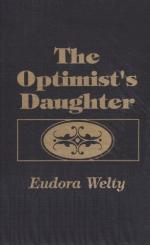|
This section contains 224 words (approx. 1 page at 400 words per page) |

|
The Optimist's Daughter Summary & Study Guide Description
The Optimist's Daughter Summary & Study Guide includes comprehensive information and analysis to help you understand the book. This study guide contains the following sections:
This detailed literature summary also contains Bibliography and a Free Quiz on The Optimist's Daughter by Eudora Welty.
The first version of Eudora Welty's best-selling, Pulitzer Prize-winning novel, The Optimist's Daughter, appeared as a short story in 1969 in the New Yorker. Revised and published as a novel in 1972, it is considered by some to be her sparest novel. In fact, Welty herself thought of the novel as more akin to a short story than a true novel. The book's complexity arises not from its length but from the emotions of the characters.
The Optimist's Daughter is the story of Laurel, a widow who returns to Mississippi when her father is ill and witnesses his death and funeral. From there, she embarks on a deeply personal journey to explore her past and her family in order to make sense of her future.
Welty's novel contains a number of autobiographical elements. Some of the male characters are inspired by Welty's uncles, and the women of the town represent Welty's observations on life in the South. Welty has stated that much of Becky McKelva's background is drawn from her mother's life in West Virginia. In fact, the novel was written not long after her mother's death, a period in which Welty was recalling her mother's life and experiences. In this way, the character of Laurel represents Welty's own desire to inquire into her past and understand how it affects her present and future.
Read more from the Study Guide
|
This section contains 224 words (approx. 1 page at 400 words per page) |

|



